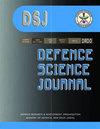危险化学物质中红外DIAL检测系统的设计分析
IF 0.8
4区 工程技术
Q3 MULTIDISCIPLINARY SCIENCES
引用次数: 0
摘要
如今,军事和公共机构都在关注大气中有毒气体和化学战剂的远程探测。差分吸收激光雷达(DIAL)是远程探测大气中有害化学物质的一种很有前途的方法。本文进行了系统设计分析,构建了一个用于有毒化学战剂、化学战模拟物、爆炸性前体和污染物检测的DIAL系统。所提出的DIAL系统包括基于光学参量振荡器(OPO)的可调谐激光器、直径203 mm的卡塞格伦望远镜、te冷却MCT探测器和合适的数据采集硬件等。对于给定的系统输入参数(脉冲能量、探测率、带宽、DAQ分辨率等),在不同的天气条件下,如晴朗的天空、中度雾霾的天空和雾霾的大气条件下,模拟了DIAL输出参数,如返回信号、信噪比和最小可测量浓度。我们考虑使用该系统检测沙林、硫二甘醇(TDG)、丙酮和甲烷等化学物质。对这些化学物质在不同地点以不同浓度进行了分析。我们的分析表明,具有5兆焦耳能量的激光发射器和203毫米接收望远镜的DIAL系统能够检测到从几十米到2公里范围内存在的有毒化学物质的几ppm浓度,并且存在地形目标。在不同的大气条件下,还估计了该系统对所考虑的化学物质的最低可检测浓度的灵敏度。可以看出,在晴朗的天气条件下,TDG的最低检测浓度为3.2 ppm,在雾霾大气下增加到9.2 ppm。对其他有毒化学品也进行了类似的分析,并在本文中进行了讨论。本文章由计算机程序翻译,如有差异,请以英文原文为准。
Design Analysis of Mid IR DIAL System for Detection of Hazardous Chemical Species
Nowadays, both military and public agencies are concerned with the remote detection of toxic gases and chemical warfare agents in the atmosphere. A promising method for the remote detection of such harmful chemicals in the atmosphere is Differential Absorption Lidar (DIAL). In the current paper, system design analysis has been carried out to build a DIAL system for the detection of toxic chemical warfare agents, chemical warfare simulants, explosive precursors, and pollutants. The proposed DIAL system comprises an Optical Parametric Oscillator (OPO) based tuneable laser, a 203 mm diameter Cassegrain telescope, a TE-cooled MCT detector, suitable data acquisition hardware, etc. The DIAL output parameters like return signals, SNR, and minimum measurable concentrations have been simulated under different weather conditions such as clear sky, moderately hazy sky, and hazy atmospheric conditions for given system input parameters (pulse energy, detectivity, bandwidth, DAQ resolution, etc.). We have considered chemicals such as Sarin, Thiodiglycol (TDG), acetone, and methane to be detected using the system. Analysis has been carried out for these chemicals present at different locations with varying concentrations. Our analysis reveals that the DIAL system with a laser transmitter of 5 mJ energy and 203 mm receiver telescope is capable of detecting a few ppm concentrations of toxic chemicals present anywhere between the ranges from a few tens of meters to 2 km with topographic target present. The sensitivity of the system in terms of minimum detectable concentrations for the considered chemicals is also estimated for different atmospheric conditions. It is seen that the minimum detectable concentration of TDG is 3.2 ppm in clear weather conditions which increases to 9.2 ppm under a hazy atmosphere. A similar analysis has been carried out for other toxic chemicals and has been discussed in the paper.
求助全文
通过发布文献求助,成功后即可免费获取论文全文。
去求助
来源期刊

Defence Science Journal
综合性期刊-综合性期刊
CiteScore
1.80
自引率
11.10%
发文量
69
审稿时长
7.5 months
期刊介绍:
Defence Science Journal is a peer-reviewed, multidisciplinary research journal in the area of defence science and technology. Journal feature recent progresses made in the field of defence/military support system and new findings/breakthroughs, etc. Major subject fields covered include: aeronautics, armaments, combat vehicles and engineering, biomedical sciences, computer sciences, electronics, material sciences, missiles, naval systems, etc.
 求助内容:
求助内容: 应助结果提醒方式:
应助结果提醒方式:


